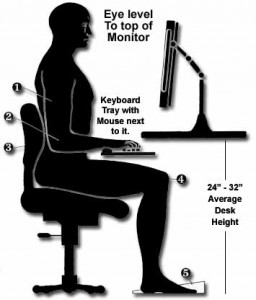If you experience back pain that restricts your activities and lasts for more than three or four days, stop holding back and visit a professional.
Many of us have a variety of bad postural habits that get in the way of good posture. Examples include heels with a height greater than two inches, carrying a heavy bag or purse over one shoulder, cradling the phone between your shoulder and ear, falling asleep on the couch in funny positions, and not sitting all the way back in a chair for proper support.
 Common contributors of poor posture
Common contributors of poor posture
- Weak muscles
- Decreased flexibility
- High heeled shoes
- Poor ergonomic work setup
- Tight muscles
- Prolonged static positions
- Foot pronation (flat feet)
- Poor sitting and standing habits
Good posture involves training your body to stand, walk, sit, and lie in positions where the least amount of strain is placed on supporting muscles and ligaments during movement, weight-bearing activities, or at rest.
Current thinking suggests that an integrated approach is the best way to tackle uncomplicated back pain. A combination of specific exercise and manual therapy, together with eliminating the triggers of your pain are often successful in getting people pointed in the right direction towards a healthy back. A significant trigger, for example, is postural difficulties related to work and daily activities of living.
Many patients that I see sit much of the day or are on their feet most of the day or night. It is these static prolonged postures that cause most musculoskeletal pain.
Correct Sitting Posture
- Always try to sit upright as much as possible with your shoulders down and back and your buttocks all the way to the back of the seat. The very back of your pelvis should be butted against the back of the chair for support. It is when the pelvis is allowed to rock backwards (slouch) that people start getting more back pain due to hanging off joints, ligaments, and tendons.
- If you use a back support make sure you sit right back into the chair. Think of trying to push your buttocks into the junction of the seat and upright back portion of the chair. That way the lumbar support of the chair or back support will help maintain the natural relaxed lumbar curve of the spine. If you don't have a lumbar support try using a small pillow; however, get right back into the chair first and then place the pillow in the small of your back to maintain the lumbar curve.
- Keep your body weight evenly distributed on both feet. Try not to cross your legs as that rotates the pelvis backwards on the side that you are crossing over causing you to hang of ligaments and tendons.
- Your knees should be bent at a right angle with the knees approximately at the level of the hips. Your feet should be flat on the floor. You can use a small foot rest under your feet to achieve the proper position.
 Don't worry we will serve you.
Don't worry we will serve you.

 Common contributors of poor posture
Common contributors of poor posture